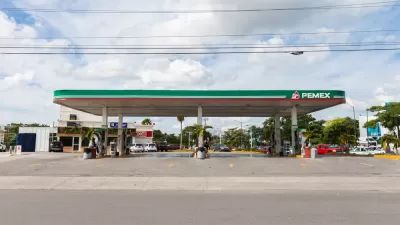Reaction to the 20 percent hike in fuel prices on New Year's Day has been swift, causing riots and looting resulting in four deaths and arrests of over 700 people, but President Enrique Peña Nieto continues to justify the need to end fuel subsidies.
In addition to the looting and fatalities, The Associated Press reports on blockades performed by truckers at ports, highways and terminals. CNN has photos showing the looting of a department store and stealing fuel at a gas station.
While the price hike has been justified by President Enrique Peña Nieto as a "responsible measure for the stability of the economy," according to a government blog, it has led to a great deal of civil unrest. Peña Nieto also emphasized that the price hike is not a result "of the Energy Reform" or increase in taxes, but of an increase in global prices.
I know that allowing gasoline to rise to its international price is a difficult change, but as president, my job is to precisely make difficult decisions now, in order to avoid worse consequences in the future," Pena Nieto said in a televised address. "Keeping gas prices artificially low would mean taking money away from the poorest Mexicans, and giving it to those who have the most."
As posted earlier, the hike is result of energy reform, specifically the deregulation of fuel prices to allow for prices to be determined, in part, by global oil prices. However, the energy reform that Peña Nieto was likely referring to is the 2013 proposal to allow foreign investment in the state-owned oil company, Pemex.
The government blog elaborated on why Peña Nieto needed to end the subsidy of fuel prices from an equity perspective:
He would have had to stop funding programs in the health sector, the education sector , which are priority and which are certainly a priority for the government against which would have meant devote those resources to maintain a fixed price of gasoline.
FULL STORY: Looting, protests in Mexico over gas price hikes turn deadly

Planetizen Federal Action Tracker
A weekly monitor of how Trump’s orders and actions are impacting planners and planning in America.

San Francisco's School District Spent $105M To Build Affordable Housing for Teachers — And That's Just the Beginning
SFUSD joins a growing list of school districts using their land holdings to address housing affordability challenges faced by their own employees.

The Tiny, Adorable $7,000 Car Turning Japan Onto EVs
The single seat Mibot charges from a regular plug as quickly as an iPad, and is about half the price of an average EV.

With Protected Lanes, 460% More People Commute by Bike
For those needing more ammo, more data proving what we already knew is here.

In More Metros Than You’d Think, Suburbs are Now More Expensive Than the City
If you're moving to the burbs to save on square footage, data shows you should think again.

The States Losing Rural Delivery Rooms at an Alarming Pace
In some states, as few as 9% of rural hospitals still deliver babies. As a result, rising pre-term births, no adequate pre-term care and "harrowing" close calls are a growing reality.
Urban Design for Planners 1: Software Tools
This six-course series explores essential urban design concepts using open source software and equips planners with the tools they need to participate fully in the urban design process.
Planning for Universal Design
Learn the tools for implementing Universal Design in planning regulations.
Smith Gee Studio
City of Charlotte
City of Camden Redevelopment Agency
City of Astoria
Transportation Research & Education Center (TREC) at Portland State University
US High Speed Rail Association
City of Camden Redevelopment Agency
Municipality of Princeton (NJ)



























